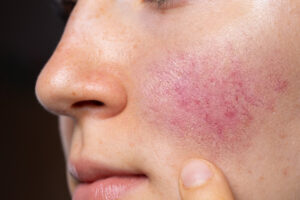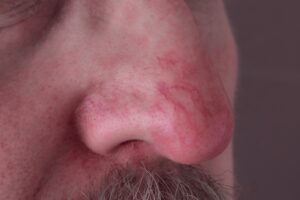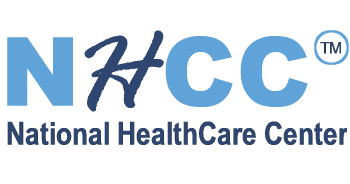
If you’re looking for treatment for rosacea in Stockbridge, GA, you might be curious about how you can better care for your skin. If you’re prone to red skin or flush easily, you may have rosacea. Rosacea is a common skin condition that affects an estimated 16 million Americans. It causes the skin to flush and turn red, and can also cause pus-filled bumps and pimples. In some cases, rosacea can lead to more serious problems such as eye irritation, swollen eyelids, and even trouble seeing clearly. While there is no cure for rosacea, there are treatments available that can help control the symptoms. In this article, we will discuss what rosacea is, what it looks like, what causes it, and the different treatment options available.
What Is Rosacea?
This relatively common skin condition may appear like a flushed or ruddy complexion, but may flare up and worsen for weeks to months at a time, during which period pus-filled bumps or pimples may also appear. Rosacea is commonly mistaken for acne, though it’s most commonly found in middle-aged Caucasian women.
What Are the Symptoms of Rosacea?
Rosacea is characterized by redness or ruddiness of complexion that may include other visual cues as well. While rosacea may present differently in each individual, common symptoms or signs of rosacea include:
- Visible veins and blood vessels (also called “spider veins”), typically on the nose and cheeks
- Flushed, red skin, which may be more difficult to spot on people with darker skin
- A sensation of burning on the reddened skin, which may feel inflamed and tender
- Pus-filled bumps that resemble acne, but are in fact a separate condition
- Ocular rosacea, or dry, swollen, inflamed eyelids. These symptoms may even occur before the skin symptoms.
- A bulbous nose (rhinophyma). Rosacea can gradually thicken the skin on the nose, causing it to appear enlarged in scale when compared to the other features of the face.
What Does Rosacea Look Like?
Depending on the severity of the case, rosacea can manifest in frequent blushing or flushing of the face to ocular rosacea or rhinophyma that affects the physical features of the face (eyes and nose). Oftentimes, rosacea includes spider veins and pus-filled pimples that are distinct from acne, because they do not have blackheads.

What Causes Rosacea?
Even though rosacea is quite common, the exact cause is not known. However, there are a few factors that may increase a person’s likelihood of experiencing a flare up of rosacea. These factors include:
- Heightened immune system response
- Family genetics
- Environmental factors
- Spicy or hot food or drinks
- Alcohol
- Exposure to wind or sun
- Heavy exercise
- Emotional distress
- Experiencing temperature extremes
- Certain topical or cosmetic products
- Any prescriptions that dilate blood vessels, including certain blood pressure medications
Also, it’s important to note that rosacea is slightly more common in females, particularly those over the age of 30. Rosacea is all the more likely if a female over 30 smokes and/or has a tendency to easily burn when exposed to the sun.
It is also speculated that rosacea may be caused by a strain of bacteria called bacillus oleronius, though rosacea has also been linked to skin mites as well. However, rosacea isn’t necessarily caused by poor hygiene—to a degree, bacteria on your skin and skin mites are natural.
Are Rosacea and Shingles Related?
The answer to this question is “perhaps.” According to a recent study from the Journal of the American Academy of Dermatology, those who experience chronic inflammatory skin diseases may also have an increased risk for shingles (or herpes zoster). Rosacea is considered a chronic inflammatory skin disease so it is possible that it may increase an individual’s likelihood of contracting shingles.
Which Foods Trigger Rosacea?
While triggers for rosacea vary from individual to individual, there are certain foods and drinks that are best to avoid if you’re hoping to sidestep a flare-up. Common trigger foods include:
- Spicy food
- Tomatoes, citrus, chocolate, or any other foods containing cinnamaldehyde
- Alcohol
- Hot beverages
- Foods high in histamines (cheese and other aged or fermented products, processed meats, pickles, or wine)
Which Acid for Rosacea?
Plenty of skincare products rely on acidic ingredients (like ascorbic acid, glycolic acid, hyaluronic acid, and salicylic acid) as a regular part of maintaining your skin’s health—so which acid is best for rosacea?
If you’re looking for a topical treatment for rosacea, one common ingredient in creams and gels is azelaic acid, which is used to treat both acne and rosacea. Azelaic acid reduces inflammation and rosacea symptoms while also killing acne-causing bacteria.
Can Rosacea Be Cured?
While there is no cure for rosacea, there are ways you can manage the symptoms. Typically, treatment for rosacea involves a combination of practicing good skin hygiene and applying topical or oral medications. Symptoms of rosacea can be managed using the following methods:
- Prescription antibiotics: Sometimes, a dermatologist will prescript an oral antibiotic (such as doxycycline) to help control the pimple-like bumps associated with rosacea.
- Topical gels or creams: A common approach to treating rosacea is through tropical drugs—especially for more moderate cases of rosacea. The primary function of these topical medications is to reduce inflammation by constricting the blood vessels, though this effect is only temporary and the medication must be regularly reapplied. Another type of topical medication that is commonly prescribed is an azelaic acid-based cream to help control the acne-like symptoms of rosacea.
- Oral acne prescription: For cases of rosacea that are a little more resistant to treatment, sometimes dermatologists will prescribe an oral acne medication such as isotretinoin that can help to mitigate the pus-filled lesions that can come with rosacea. This type of medication is typically only used as a last resort as it is very powerful, and can cause birth defects if used by pregnant women.
- Laser therapy: This type of treatment is used to minimize the appearance of enlarged blood vessels—but it’s typically more noticeable on people with paler complexions than those blessed with more melanin. It is important to note that because this procedure is considered cosmetic, it is not covered by most insurance policies.
Treatment for Rosacea Stockbridge, GA
Rosacea flare-ups can occur for any number of reasons, but there are steps you can take to better care for yourself and take control of your skin health. By learning your triggers, practicing good skin hygiene, and following your dermatologist’s recommended prescription plan, you are likely to minimize the unwanted effects of this chronic inflammatory skin disease and enjoy a good quality of life.
Are you looking for treatment for rosacea in Stockbridge, GA? Contact National Healthcare Center today to book an appointment and start prioritizing your skin care!


